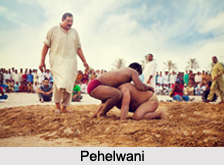 History of Pehlwani began as an ancient South Asian form of wrestling, which is called malla-yuddha. Pehlwani was practiced at least since the 5th millenniun BC, described in the 13th century treatise Malla Purana. It was the precursor of modern kushti.
History of Pehlwani began as an ancient South Asian form of wrestling, which is called malla-yuddha. Pehlwani was practiced at least since the 5th millenniun BC, described in the 13th century treatise Malla Purana. It was the precursor of modern kushti.
Early History of Pehlwani
Pehlwani was practiced in early era of 5th century BC. It evolved during the Mauryan Era.
Medieval History of Pehlwani
In the 16th century, the Central Asian Mughals, who were of Turko-Mongol descent, conquered northern India. Through the influence of Iranian and Mongolian wrestling, they incorporated groundwork to the local malla-yuddha, thereby creating modern kushti. Babur, the first Mughal emperor, was a wrestler himself and could reportedly run very fast for a long distance while holding a man under each arm. Mughal-era wrestlers sometimes even wore "Bagh naka" on one hand, in a variation called "naki ka kushti" or "claw wrestling".
Modern History of Pehlwani
After the decline of Mughal Empire, British East India Company came in the power. Ramadasa the "father of Indian athletics" travelled the country encouraging Hindus to physical activity in homage to the great god Lord Hanuman. The Maratha rulers supported kushti by offering large sums of prize money for tournament champions. It was said that every Maratha boy at the time could wrestle and even women took up the sport. During the colonial period, local princes sustained the popularity of kushti by hosting matches and competitions. Wrestling was the favourite spectator sport of the Rajputs, and were said to look forward to tournaments. Every Rajputs prince or chief had a number of wrestling champions to compete for his entertainment. The greatest wrestling centers were said to be Uttar Pradesh and the Punjab. In 1909, a Bengali merchant named Adbul Jabbar Saudagar intended to unite the local youth and inspire them in the anti-British struggle against the colonists through a display of strength by holding a wrestling tournament. It was known as Jabbar-er Boli Khela. This competition has continued through independence and the subsequent partition of India.
In the more recent past, India had famous wrestlers of the class of the Great Gama (of British India and later Pakistan, after partition) and Gobar Guha. India reached its peak of glory in the IV Asian Games in 1962 when all the seven wrestlers were placed on the medallist and in between them they won 12 medals in freestyle wrestling and Greco-Roman wrestling. A repetition of this performance was witnessed again when all the 8 wrestlers sent to the Commonwealth Games held at Kingston, Jamaica had the distinction of getting medals for the country. During the 1960s, India was ranked among the first eight or nine wrestling nations of the world and hosted the world wrestling championships in New Delhi in 1967.
Pehlwan who compete in wrestling nowadays are also known to cross train in the grappling aspects of judo and jujutsu. The legendary wrestlers from the bygone era like Karl Gotch have made tours to India to learn kushti and further hone their skills. Karl Gotch was even gifted a pair of mugdar. The conditioning exercises of Pehlwani have been incorporated into many of the conditioning aspects of both catch wrestling and shoot wrestling, along with their derivative systems.